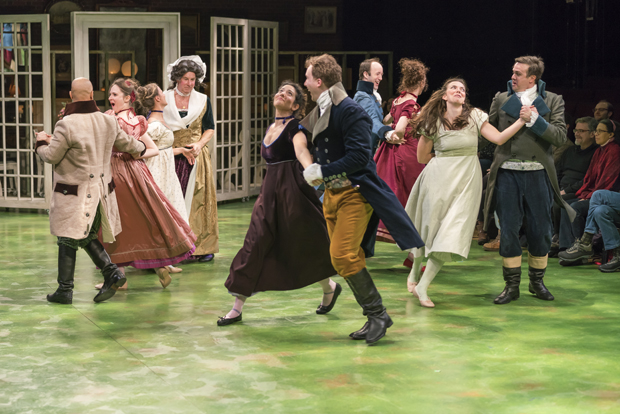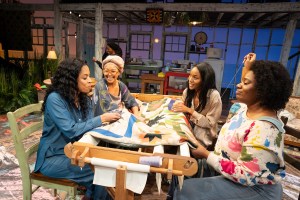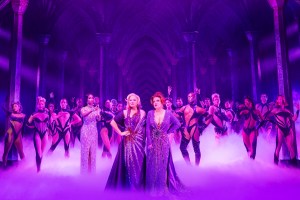Sense and Sensibility
A 21st-century adaptation of a Jane Austen novel whirls its way through the eternal quest for a suitable marriage.

(© Ashley Garrett)
If you prefer your Jane Austen with tea and lacy-thin cookies, you'll be taken aback by Bedlam's stage version of Sense and Sensibility, brewed with a kick of cognac in the cup. This adaptation by Kate Hamill, which received rapturous reviews at its New York premiere in 2016, has been directed again by Eric Tucker, this time for the American Repertory Theater.
The story begins with the death of Mr. Dashwood, the head of a family comprising the second Mrs. Dashwood and three daughters. Alas, there is also a son from his first marriage, John Dashwood (Benjamin Russell) and his grasping wife (Katie Hartke), who inherit the estate and the family manor, forcing the patriarch's family to leave their home. A generous cousin, Sir John Middleton (Ryan Quinn), and his mother-in-law, Mrs. Jennings (a kindly but dotty Nigel Gore in the cross-gender skirt role of the British "panto"), offer the near-penniless women a modest house in the countryside.
Sans dowries, the two elder Dashwood girls must find themselves husbands amid the swirl of table talk over teacups, the favorite pastime of the gentry, which includes their neighbors and family. Elinor (a sensible Maggie Adams McDowell, in control of her feelings but heartbroken at the family situation) and Marianne (the passionate Jessica Frey, who cares nothing for the opinions of the crowd) have fallen in love with men who are unavailable or otherwise engaged. Elinor pines for the awkward, sweet, stuttering Edward Ferrars (Jamie Smithson), who has no profession, ambition, nor the courage to claim her. Marianne falls literally for the disreputable John Willoughby (Russell again), who rescues her when she twists her ankle out on a walk, while the patient but restrained Colonel Brandon (James Patrick Nelson) burns for her in silence.
The production spreads itself down a long, alley-like space in the center of the theater. Viewers seated on either side watch a splendid ensemble of 10 actors — some in multiple roles — whiz in and out on chairs equipped with castors, narrowly missing the ever-moving set pieces, also on wheels. The cast acts as stage crew as well, rolling the various props into the playing space so quickly that one scene often begins before the other has spun offstage (scenic design by John McDermott).
The performers reveal the complexities of the characters' personalities with virtuosic skill, especially Smithson's hilarious cameo as Edward's dissolute, drunken brother, Robert. Choreography by Alexandra Beller enlivens the action that begins with a meet-and-greet between audience and actors, who are cavorting as if they were on the dance floor of a club. They gradually shed their modern clothing, a piece at a time, while changing into period dress (designed by Angela Huff). They arrange themselves by couples into a procession entering in tempo, steps, and formations of late 18th-century ballroom dance. The transformation serves to propel the actors into their characters while inviting the audience into the shared theatrical experience.
If the eternal search for a suitable mate is one central theme of Jane Austen's story, money is the other — gossiped about, conjectured over, and driving the sometimes desperate and deceptive encounters between the haves and the have-nots. Reading the novels of Jane Austen and seeing the characters in the Hamill-Tucker adaptation come to life onstage confirm how little human nature has changed over the course of 150 years or so, even if the methods of communication have allowed rumor, innuendo, and false news to spread further and faster.










